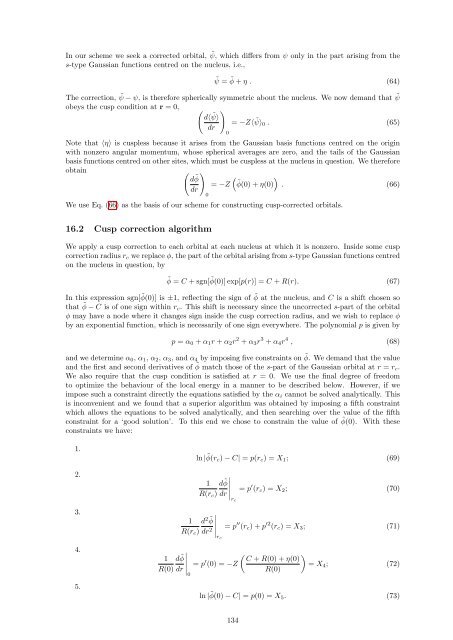CASINO manual - Theory of Condensed Matter
CASINO manual - Theory of Condensed Matter
CASINO manual - Theory of Condensed Matter
Create successful ePaper yourself
Turn your PDF publications into a flip-book with our unique Google optimized e-Paper software.
In our scheme we seek a corrected orbital, ˜ψ, which differs from ψ only in the part arising from the<br />
s-type Gaussian functions centred on the nucleus, i.e.,<br />
˜ψ = ˜φ + η . (64)<br />
The correction, ˜ψ − ψ, is therefore spherically symmetric about the nucleus. We now demand that ˜ψ<br />
obeys the cusp condition at r = 0, (<br />
d〈 ˜ψ〉<br />
)<br />
= −Z〈<br />
dr<br />
˜ψ〉 0 . (65)<br />
0<br />
Note that 〈η〉 is cuspless because it arises from the Gaussian basis functions centred on the origin<br />
with nonzero angular momentum, whose spherical averages are zero, and the tails <strong>of</strong> the Gaussian<br />
basis functions centred on other sites, which must be cuspless at the nucleus in question. We therefore<br />
obtain (<br />
d ˜φ<br />
dr<br />
)<br />
0<br />
( )<br />
= −Z ˜φ(0) + η(0) . (66)<br />
We use Eq. (66) as the basis <strong>of</strong> our scheme for constructing cusp-corrected orbitals.<br />
16.2 Cusp correction algorithm<br />
We apply a cusp correction to each orbital at each nucleus at which it is nonzero. Inside some cusp<br />
correction radius r c we replace φ, the part <strong>of</strong> the orbital arising from s-type Gaussian functions centred<br />
on the nucleus in question, by<br />
˜φ = C + sgn[ ˜φ(0)] exp[p(r)] = C + R(r). (67)<br />
In this expression sgn[ ˜φ(0)] is ±1, reflecting the sign <strong>of</strong> ˜φ at the nucleus, and C is a shift chosen so<br />
that ˜φ − C is <strong>of</strong> one sign within r c . This shift is necessary since the uncorrected s-part <strong>of</strong> the orbital<br />
φ may have a node where it changes sign inside the cusp correction radius, and we wish to replace φ<br />
by an exponential function, which is necessarily <strong>of</strong> one sign everywhere. The polynomial p is given by<br />
p = α 0 + α 1 r + α 2 r 2 + α 3 r 3 + α 4 r 4 , (68)<br />
and we determine α 0 , α 1 , α 2 , α 3 , and α 4 by imposing five constraints on ˜φ. We demand that the value<br />
and the first and second derivatives <strong>of</strong> ˜φ match those <strong>of</strong> the s-part <strong>of</strong> the Gaussian orbital at r = r c .<br />
We also require that the cusp condition is satisfied at r = 0. We use the final degree <strong>of</strong> freedom<br />
to optimize the behaviour <strong>of</strong> the local energy in a manner to be described below. However, if we<br />
impose such a constraint directly the equations satisfied by the α i cannot be solved analytically. This<br />
is inconvenient and we found that a superior algorithm was obtained by imposing a fifth constraint<br />
which allows the equations to be solved analytically, and then searching over the value <strong>of</strong> the fifth<br />
constraint for a ‘good solution’. To this end we chose to constrain the value <strong>of</strong> ˜φ(0). With these<br />
constraints we have:<br />
1.<br />
2.<br />
3.<br />
4.<br />
5.<br />
1<br />
R(0)<br />
ln | ˜φ(r c ) − C| = p(r c ) = X 1 ; (69)<br />
1<br />
R(r c )<br />
d ˜φ<br />
= p ′ (r<br />
dr ∣ c ) = X 2 ; (70)<br />
rc<br />
1 d 2 ˜φ<br />
∣ ∣∣∣∣rc<br />
R(r c ) dr 2 = p ′′ (r c ) + p ′2 (r c ) = X 3 ; (71)<br />
d ˜φ<br />
( )<br />
C + R(0) + η(0)<br />
= p ′ (0) = −Z<br />
= X 4 ; (72)<br />
dr ∣ R(0)<br />
0<br />
ln | ˜φ(0) − C| = p(0) = X 5 . (73)<br />
134

















